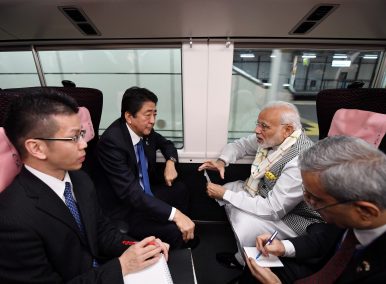By Sangeeta Mahapatra
 In scenic Yamanashi, where Japanese Prime Minister Shinzo Abe together with his Indian counterpart Narendra Modi met over a individual dinner together with a brief tutorial on the role of chopsticks, at that spot was a clear feel of bonhomie together with trust. The 13th annual coming together betwixt the leaders of the 2 countries included a see to a Fuji Automatic Numerical Control (FANUC) factory.
In scenic Yamanashi, where Japanese Prime Minister Shinzo Abe together with his Indian counterpart Narendra Modi met over a individual dinner together with a brief tutorial on the role of chopsticks, at that spot was a clear feel of bonhomie together with trust. The 13th annual coming together betwixt the leaders of the 2 countries included a see to a Fuji Automatic Numerical Control (FANUC) factory. Deep inwards the forests nigh Mount Fuji, the largest industrial robot manufacturer inwards the world showcased products that assist move on the assembly lines of about of the leading global brands, including Apple, running. The see was significant, non alone because it showed growing bilateral cooperation inwards emerging technologies betwixt Bharat together with Japan, but also because it highlighted the shift toward leaner, to a greater extent than globally competitive, manufacturing aided past times automation, artificial intelligence (AI), together with the creation of novel skills sets. There are other implications too: increased cooperation inwards areas including defence, as evident from the goals of co-development together with co-production inwards the Japan-India Vision 2025. In July 2018, the 2 sides agreed to collaborate on dual-use technologies to strengthen defence cooperation, including interrogation on unmanned soil vehicle robotics.
Modi highlighted this aspect of bilateral ties when he claimed Nippon to live on India’s almost trusted partner inwards economical together with technological modernization, together with that “[India’s] software together with Japan’s hardware tin produce wonders” to a gathering of businesspersons inwards Tokyo. What lent acceptance to the rhetoric was that he has met Abe 12 times since taking part inwards 2014. It heralds a clear attempt to boost investments together with motion toward “Industry 4.0” that volition live on increasingly driven past times automation, the cyberspace of things (IoT), 3D Printing, AI, robotics, together with 5G technology.
In price of investment, Nippon has been India’s 3rd largest rootage of FDI, providing $28.16 billion from Apr 2000 to June 2018, inwards various sectors. In 2014, Nippon committed $462 1 M m inwards authorities together with individual sector investments over v years. The get instalment of the $15 billion earmarked for the Ahmedabad-Mumbai bullet develop service, expected to live on completed past times 2022, has been released. The capstone of Japan’s investment is the $90 billion Delhi-Mumbai Industrial Corridor, spread across half dozen Indian states, which volition take away edifice novel cities, industrial parks, ports, airports, together with a 1,483 km high-speed rails together with route line. Both governments are expected to contribute as to the project.
For Japan, at that spot is high render on investment, non alone inwards price of big-ticket infrastructure projects, but securing access to a booming export marketplace for its merchandise trade. The Indian marketplace provides an attractive option against the backdrop of Japan’s exports dipping for the get fourth dimension since 2016, next the merchandise state of war betwixt the United States together with China. The enablers for boosting bilateral merchandise inwards goods together with services, including the removal of tariff on 94 per centum of tradeable items, are seat out inwards the Comprehensive Economic Partnership Agreement implemented inwards August 2011. The Japanese ambassador to India, Kenji Hiramatsu acknowledged India’s improvement inwards the World Bank’s ease of doing business ranking.
Japan is a leading partner inwards India’s “Make inwards India,” “Start-up India,” “Skill India,” together with “Digital India” initiatives. Many Japanese companies accept relocated to India to back upwards Make inwards India. Japan’s hardware inwards the sort of cars together with electrical appliance markets tin complement India’s software inwards price of skilled personnel. With both Bharat together with Nippon aiming to shore upwards the start-up sector, inwards May 2018 the Japan-India Start-up hub was established inwards India’s I.T. capital, Bengaluru. Many startups aim to service the manufacturing sector amongst frontline technologies. The Indian authorities volition assist Japanese companies find local partners. Nippon volition invite Indian start-ups amongst competitive technologies to collaborate amongst large Japanese companies.
Japan’s largest state-sponsored interrogation institute, the National Institute of Advanced Industrial Science together with Technology, together with the Indian Institute of Technology, Hyderabad, volition live on working on articulation studies inwards picture recognition together with mightiness afterwards function on 5G wireless communications. Several Japanese venture capitalists similar Soft Bank Group Corp. (has committed to invest $10 billion inwards the Indian marketplace past times 2024), Incubate Fund, Beenext, Anew Holdings, Rebright Partners, GREE Ventures, together with Mistletoe are increasing their Indian portfolios. Nippon plans to get a one-year visa programme to attract skilled Indians.
The coming together betwixt Modi together with Abe marks a progression inwards diplomatic relations betwixt the 2 countries. Their appointment on a attain of global together with regional issues, including maritime cooperation inwards the Indo-Pacific region, could render a counterpoint to Chinese potency inwards the region. Technological together with economical cooperation tin bolster these efforts.
Dr. Sangeeta Mahapatra is a visiting swain at the Institute of Asian Studies, High German Institute of Global together with Area Studies, Hamburg, Germany.
Buat lebih berguna, kongsi:
